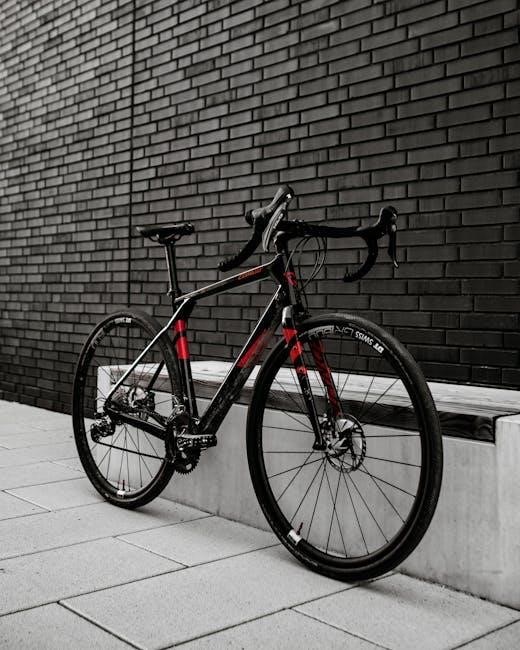Choosing the right Specialized bike size is crucial for comfort and performance. This guide helps you navigate Specialized’s sizing charts, ensuring an optimal riding experience. Understand the importance of frame fit for different bike models.
Importance of Correct Bike Size
Selecting the correct bike size is paramount for comfort, efficiency, and injury prevention. A well-fitted Specialized bike ensures optimal power transfer and reduces strain on joints. Improper sizing can lead to discomfort, pain, and reduced performance. The right frame size enhances handling, stability, and overall riding enjoyment. Consider height, inseam, and reach when determining the appropriate size.
A correctly sized bike improves control and confidence on various terrains. It allows for proper weight distribution and balanced handling. Investing time in finding the right fit maximizes your investment in a Specialized bike. Consulting size charts and seeking professional advice are essential steps. Prioritize a comfortable and efficient riding position for long-term enjoyment.
Understanding Specialized Sizing Charts
Specialized sizing charts provide guidance for selecting the right frame size. These charts often use height and other measurements. Understanding these charts is key to finding a comfortable and efficient bike fit.
Height-Based Sizing
Height is a primary factor in determining the correct Specialized bike size. Specialized provides detailed sizing charts that correlate rider height to frame size for various models. These charts are a good starting point for finding your ideal fit. For example, specific height ranges correspond to XS, S, M, L, XL, and XXL frame sizes on trail bikes. It’s important to consult the specific chart for the bike model you’re interested in, as sizing can vary. Using height as a guide ensures a foundational fit, which can then be fine-tuned with other measurements and adjustments. Always consider the model-specific height chart.
Reach and its Importance
Reach is a critical measurement in bike sizing, indicating the horizontal distance from the bottom bracket to the head tube. It significantly affects your riding posture and comfort. A proper reach ensures balanced weight distribution and efficient power transfer. When between sizes, consider reach to determine which frame feels more comfortable and responsive. Riders with longer torsos may prefer a longer reach. Specialized’s S-sizing system emphasizes reach, allowing riders to choose a frame based on desired handling characteristics rather than just height. Adjusting stem length can further refine reach for a personalized fit.

Specialized Bike Models and Their Sizing
Specialized offers a diverse range of bikes, each with specific sizing considerations. Understanding these nuances ensures you select the perfect frame for your chosen discipline and riding style.
Mountain Bike Sizing (e.g., Stumpjumper, Epic)
Specialized mountain bike sizing, particularly for models like the Stumpjumper and Epic, is crucial for trail performance and comfort. Size charts guide riders based on height, ensuring optimal handling and control. For trail bikes, Specialized suggests specific frame sizes for different height ranges. Consider reach, which affects how long the bike feels, especially if you’re between sizes.
Newer geometry on models like the Epic might make a larger frame more suitable. Test rides are essential to determine the best fit. Ultimately, balance sizing charts with personal feel. The correct frame size optimizes the riding experience on challenging terrains.
Road Bike Sizing (e.g., Tarmac, Roubaix, Allez)
Specialized road bikes, like the Tarmac, Roubaix, and Allez, require precise sizing for optimal efficiency and comfort. Specialized provides detailed size charts using height to determine the best frame. Choosing the correct size is crucial, especially for the Roubaix, which offers an expansive size range.
Consider the bike’s reach to ensure proper upper body positioning. If between sizes, focus on how the bike feels while riding. The right size maximizes comfort and performance on every ride. Explore detailed sizing guides for specific road bike models to find the ideal fit for your body and riding style.

S-Sizing Explained
S-Sizing is Specialized’s MTB sizing approach, allowing riders to choose frame size based on riding style, not just height. It offers more flexibility, letting riders prioritize maneuverability or stability.
What is S-Sizing?
S-Sizing is Specialized’s innovative approach to mountain bike sizing, moving away from traditional height-based sizing. Instead of designating sizes as small, medium, or large, Specialized uses designations like S1, S2, S3, and so on. This system encourages riders to choose a bike size based on their preferred riding style and the desired handling characteristics, rather than solely on their height.
This allows for a more personalized fit, where riders can opt for a smaller frame for increased maneuverability or a larger frame for enhanced stability at higher speeds. S-Sizing acknowledges that rider preference and terrain play a significant role in selecting the ideal bike size.
Benefits of S-Sizing
S-Sizing offers numerous advantages over traditional sizing methods. It allows riders to prioritize handling characteristics, choosing a smaller size for playfulness and agility or a larger size for stability and confidence at speed. This system accommodates diverse riding styles and preferences.
S-Sizing also provides more flexibility for riders who fall between traditional sizes. Instead of being limited to a potentially awkward fit, they can select the S-Size that best matches their desired riding experience. This leads to improved comfort, control, and overall enjoyment on the trails. Ultimately, S-Sizing empowers riders to fine-tune their bike fit for optimal performance.
Geometry Charts and Their Role
Geometry charts are essential for understanding bike fit. They provide detailed measurements of a bike frame, aiding in selecting the right size. Learn to interpret these charts for optimal performance and comfort.
How to Read a Geometry Chart
Understanding a geometry chart is crucial for selecting the correct bike size. These charts provide detailed measurements of a bike’s frame, including key dimensions like reach, stack, and wheelbase. Reach indicates the horizontal distance from the bottom bracket to the head tube, influencing the bike’s feel. Stack is the vertical distance from the bottom bracket to the top of the head tube, affecting handlebar height. Wheelbase is the distance between the front and rear axles, impacting stability. Head tube angle and seat tube angle influence handling and pedaling efficiency. Examining these measurements helps riders choose a frame that matches their body dimensions and riding style, ensuring comfort and optimal performance.

Tips for Choosing Between Sizes
When between sizes, consider your riding style and flexibility. A smaller frame offers more agility, while a larger frame provides stability. Test ride both sizes if possible to determine the best fit.
When You’re Between Sizes
Finding yourself between sizes on a Specialized bike chart is common. It means either frame could work. Focus on ‘reach,’ the bike’s length when riding, influenced by your upper body. For trail bikes, a bigger frame offers stability; smaller, more agility. Test ride both if possible.
Consider stem length adjustments to fine-tune the fit. If prioritizing speed, the Epic 8 might suit you. The larger Epic frame could fit better with the newer geometry, but balance with test rides and stem adjustments. Ultimately, personal feel is key.

Where to Find Specialized Size Charts
Locate Specialized size charts on their official website. Retailers and local bike shops also provide these charts. These resources will guide you in determining the correct frame size for your Specialized bike.
Specialized Website
The Specialized website is a primary source for finding comprehensive and up-to-date size charts; Navigate to the specific bike model you’re interested in, such as the Tarmac or Stumpjumper, and look for the “Size Chart” or “Geometry” section. These charts provide detailed information about frame sizes, reach, stack, and other crucial measurements. You’ll typically find height-based recommendations, helping you match your height to the appropriate frame size.
The website also often includes geometry charts, which offer a more in-depth understanding of the bike’s dimensions; Remember to check the model year, as sizing can vary between different years of the same bike.
Retailers and Bike Shops
Visiting authorized Specialized retailers and bike shops offers a hands-on approach to finding the right size. Experienced staff can assist you in interpreting size charts and geometry, providing personalized recommendations based on your body measurements and riding style. They can also help you compare different models and sizes, allowing you to test ride bikes and feel the differences firsthand.
Bike shops often have fitting tools and expertise to fine-tune your position, ensuring optimal comfort and efficiency. Furthermore, retailers can offer insights into specific bike models and their sizing nuances. Don’t hesitate to ask questions and seek their guidance.
